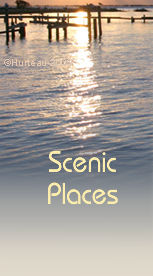 |
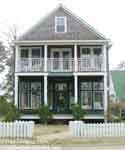 |
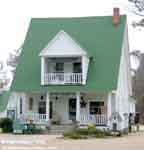 |
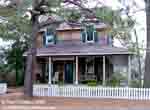 |
| These
restored homes now serve as shops |
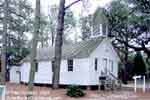 |
| Corolla
Schoolhouse, 1890 |
Historic
Corolla
In the 1970's little more than a
dozen people lived in the village of Corolla (see Coastal
Guide Map), and the paved road reached only to Duck.
Corolla was still nearly as isolated as it was a century
earlier, in 1875, when the Currituck
Beach Lighthouse was completed near the Jones Hill
Life Saving Station, itself having been completed just
one year earlier. At that time the lighthouse keepers,
Life Saving Station surfmen and their families numbered
greater than a dozen by themselves. Back then the area
was known as Jones Hill, and did not take on the name
Corolla until much later.
 |
| Corolla
Chapel, 1885 |
Even
in 1975 when a private developer built a private road
northward from Duck, it stopped short of reaching Corolla
village and was open only to residents and local property
owners. Then finally, in 1984, the state took over the
private road, making it part of Highway 12, and extended
it through Corolla to where it now ends at the beach ramp.
Since then, the area has exploded with homes, chain and
franchise businesses, and tourism. Despite this mad rush
of growth and construction, the historic heart of Corolla
is still a dirt road with quaint shops, and a 19th century
chapel and restored schoolhouse. A visit to this spot,
down a dirt side street off Highway 12, gives a feel for
the quietude and simple pace of days gone by. |
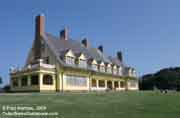 |
| Whalehead
Club viewed from the southwest |
 |
| A
panoramic view of the Whalehead Club from the gallery
of Currituck Beach Lighthouse |
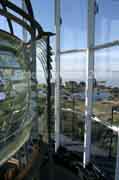 |
| A
unique view of the Whalehead Club from the Currituck
Beach Lighthouse lantern room |
Another
of the older buildings in Corolla is the Whalehead Club.
Construction was completed on this grand art nouveau building
in 1925. It was originally named Corolla Island, and served
as a private residence. When the original owners died,
the property was sold and was renamed Whalehead Club by
its new owner.
Then in the '70's, when serious
development began north of Duck, parts of the original
property were sold off. Eventually, the remaining land
and structure was purchased by Currituck County for restoration
and conversion into a museum. It became part of the current
Currituck Heritage Park, which includes the Currituck
Beach Light Station, and the new Outer Banks Center for
Wildlife Education being constructed between the Whalehead
Club and the lighthouse by the North Carolina Wildlife
Resources Commission.
|
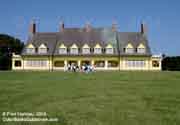 |
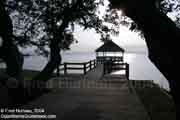 |
 |
South
side of the
Whalehead Club |
Whalehead
Club gazebo
on the sound |
Boathouse
view of the arched bridge over the Whalehead Club harbor
entrance |
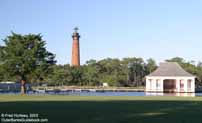 Of
course, Corolla's most famous historic site is its lighthouse,
which preceded the Whalehead Club by half a century. The
photo at left shows Currituck
Beach Lighthouse viewed from the Whalehead Club. The
beautifully restored grand Victorian Keeper's Quarters
at the light station adds greatly to the appeal of this
historic location. One of only two lighthouses open for
climbing on the Outer Banks, it is a "must see" on any
visit to Corolla.
Of
course, Corolla's most famous historic site is its lighthouse,
which preceded the Whalehead Club by half a century. The
photo at left shows Currituck
Beach Lighthouse viewed from the Whalehead Club. The
beautifully restored grand Victorian Keeper's Quarters
at the light station adds greatly to the appeal of this
historic location. One of only two lighthouses open for
climbing on the Outer Banks, it is a "must see" on any
visit to Corolla.
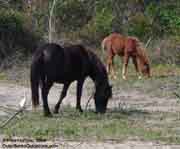 There
is one other historic aspect associated with Corolla which
has endured for over four centuries. Wild horses have
roamed free around the area of Corolla since the earliest
ventures to the new world by Spanish and English explorers
and settlers. The explosion of building, tourism and resulting
traffic which arose from the newly opened Hwy. 12 through
Corolla forced the move of the wild horses farther north
to safer areas, away from cars and highways. For more
on these enduring wild horses, continue on with your exploration
to the "Wild
Horses of Corolla". There
is one other historic aspect associated with Corolla which
has endured for over four centuries. Wild horses have
roamed free around the area of Corolla since the earliest
ventures to the new world by Spanish and English explorers
and settlers. The explosion of building, tourism and resulting
traffic which arose from the newly opened Hwy. 12 through
Corolla forced the move of the wild horses farther north
to safer areas, away from cars and highways. For more
on these enduring wild horses, continue on with your exploration
to the "Wild
Horses of Corolla". |
|
|

